Grand Mosque seizure
The Grand Mosque seizure[6] occurred during November and December 1979 when armed civilians calling for the overthrow of the House of Saud took over Masjid al-Haram in Mecca, Saudi Arabia. The insurgents, led by Juhayman al-Otaybi, declared that the Mahdi (the "redeemer of Islam") had arrived in the form of one of their leaders, Mohammed Abdullah al-Qahtani, and called on Muslims to obey him. For nearly two weeks, Saudi Special Forces, advised by three GIGN French commandos (who converted to Islam to be a part of the mission)[7][8] who fought battles to reclaim the compound.[9]
| Grand Mosque seizure | |||||||
|---|---|---|---|---|---|---|---|
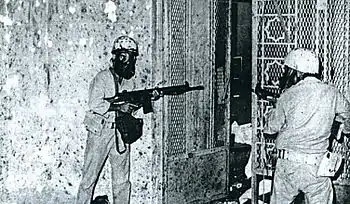 Saudi soldiers fighting their way into the Ka'aba underground beneath the Grand Mosque of Mecca, 1979 | |||||||
| |||||||
| Belligerents | |||||||
|
| |||||||
| Commanders and leaders | |||||||
|
| ||||||
| Strength | |||||||
| 300–600 militants[3] | ||||||
| Casualties and losses | |||||||
|
| ||||||
| Part of a series on: Islamism |
|---|
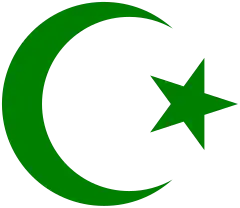 |
|
|
The seizure of Islam's holiest site, the taking of hostages from among the worshippers and the deaths of hundreds of militants, security forces and hostages caught in the crossfire in the ensuing battles for control of the site shocked the Islamic world. The siege ended two weeks after the takeover began and the mosque was cleared.[10] Al-Qahtani was killed in the recapture of the mosque but al-Otaybi and 67 of his fellow rebels who survived the assault were captured and later beheaded.[11][12][13]
Following the attack, the Saudi King Khalid implemented a stricter enforcement of Shariah (Islamic law),[14] giving the ulama and religious conservatives more power over the next decade, and religious police became more assertive.[15]
Background
The seizure was led by Juhayman al-Otaybi, a member of an influential family in Najd. He declared his brother-in-law Mohammed Abdullah al-Qahtani to be the Mahdi, or redeemer, who arrives on earth several years before Judgement Day. His followers embellished the fact that Al-Qahtani's name and his father's name are identical to Prophet Mohammed's name and that of his father, and developed a saying, "His and his father's names were the same as Mohammed's and his father's, and he had come to Makkah from the north", to justify their belief. The date of the attack, 20 November 1979, was the first day of the year 1400 according to the Islamic calendar; this ties in with the tradition of the mujaddid, a person who appears at the turn of every century of the Islamic calendar to revive Islam, cleansing it of extraneous elements and restoring it to its pristine purity.[16]
Al-Otaybi was from one of the foremost families of Najd. His grandfather had ridden with Ibn Saud in the early decades of the century and other of his family members were among foremost of the Ikhwan.[11] He was a preacher, a former corporal in the Saudi National Guard and a former student of Sheikh Abdel Aziz bin Baz who went on to become the Grand Mufti of Saudi Arabia.
Goals
"Al-Otaybi had turned against Bin-Baaz and began advocating a return to the original ways of Islam, among other things: a repudiation of the West; abolition of television and expulsion of non-Muslims".[17] He proclaimed that "the ruling Al-Saud dynasty had lost its legitimacy because it was corrupt, ostentatious and had destroyed Saudi culture by an aggressive policy of Westernization".[11] He regarded radio, television and working women to be great "evils".[18]
Al-Otaybi and Qahtani had met while imprisoned together for sedition, when al-Otaybi claimed to have had a vision sent by God telling him that Qahtani was the Mahdi. Their declared goal was to institute a theocracy in preparation for the imminent apocalypse. It is important to emphasize, however, that the 1979 rebels were not literally a reincarnation of the Ikhwan and to underscore three distinct features of the former: They were millenarians, they rejected the monarchy and they condemned the wahhabi ulama.[19]
Relations with ulama
Many of their followers were drawn from theology students at the Islamic University of Madinah. Al-Otaybi joined the local chapter of the Salafi group Al-Jamaa Al-Salafiya Al-Muhtasiba (The Salafi Group That Commands Right and Forbids Wrong) in Medina headed by renowned Sheikh Abdel Aziz bin Baz, chairman of the Permanent Committee for Islamic Research and Issuing Fatwas at the time.[20] The followers preached their radical message in different mosques in Saudi Arabia without being arrested.[21] The government was reluctant to confront religious extremists. When Al-Otaybi, al-Qahtani and a number of the Ikhwan were locked up as troublemakers by the Ministry of Interior security police (Mabahith) in 1978,[22] members of the ulama (including bin Baz) cross-examined them for heresy but they were subsequently released as being traditionalists harkening back to the Ikhwan, like al-Otaybi's grandfather and, therefore, not a threat.[23]
Even after the seizure of the Grand Mosque, a certain level of forbearance by ulama for the rebels remained. When the government asked for a fatwa allowing armed force in the Grand Mosque, the language of bin Baz and other senior ulama "was curiously restrained". The scholars did not declare al-Otaybi and his followers non-Muslims, despite their violation of the sanctity of the Grand Mosque, but only termed them "al-jamaah al-musallahah" (the armed group). The senior scholars also insisted that before security forces attack them, the authorities must offer them the option to surrender.[24]
Preparations
Because of donations from wealthy followers, the group was well-armed and trained. Some members, like al-Otaybi, were former military officials of the National Guard.[25] Some National Guard troops sympathetic to the insurgents smuggled weapons, ammunition, gas masks and provisions into the mosque compound over a period of weeks before the new year.[26] Automatic weapons were smuggled from National Guard armories and the supplies were hidden in the hundreds of tiny underground rooms under the mosque that were used as hermitages.[27]
Seizure
In the early morning of 20 November 1979, the imam of the Grand Mosque, Sheikh Mohammed al-Subayil, was preparing to lead prayers for the 50,000 worshippers who had gathered for prayer. At around 5:00 am he was interrupted by insurgents who produced weapons from under their robes, chained the gates shut, and killed two policemen who had been armed only with wooden clubs.[28] The number of insurgents has been given as "at least 500"[11] or "four to five hundred", and included several women and children who had joined al-Otaybi's movement.[27]
At the time the Grand Mosque was being renovated by the Saudi Binladin Group.[29] An employee of the organization was able to report the seizure to the outside world before the insurgents cut the telephone lines.
The insurgents released most of the hostages and locked the remainder in the sanctuary. They took defensive positions in the upper levels of the mosque, and sniper positions in the minarets, from which they commanded the grounds. No one outside the mosque knew how many hostages remained, how many militants were in the mosque and what sort of preparations they had made.
At the time of the event, Crown Prince Fahd was in Tunisia for a meeting of the Arab Summit. The commander of the National Guard, Prince Abdullah, was also abroad for an official visit to Morocco. Therefore, King Khalid assigned the responsibility to the Sudairi Brothers – Prince Sultan, then Minister of Defence, and Prince Nayef, then Minister of Interior, to deal with the incident.[30]
Siege
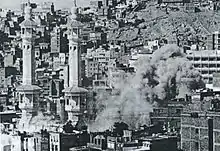
Soon after the rebel seizure, about 100 security officers of the Ministry of Interior attempted to retake the mosque, but were turned back with heavy casualties. The survivors were quickly joined by units of the Saudi Arabian Army and National Guard. At the request of the Saudi monarchy, three French Groupe d’Intervention de la Gendarmerie Nationale (GIGN) commandos were sent to advise Saudi forces in Mecca.[31][32][33]
By evening the entire city of Mecca had been evacuated. Prince Sultan appointed Turki bin Faisal Al Saud, head of the Al Mukhabaraat Al 'Aammah (Saudi Intelligence), to take over the forward command post several hundred meters from the mosque, where Prince Turki would remain for the next several weeks. However, the first order of business was to seek the approval of the ulama, which was led by Abdel Aziz bin Baz. Islam forbids any violence within the Grand Mosque, to the extent that plants cannot be uprooted without explicit religious sanction. Bin Baz found himself in a delicate situation, especially as he had previously taught al-Otaybi in Medina. Regardless, the ulama issued a fatwa allowing deadly force to be used in retaking the mosque.[34]
With religious approval granted, Saudi forces launched frontal assaults on three of the main gates. Again the assaulting force was repulsed as they were unable to break through the insurgents' defences. Snipers continued to pick off soldiers who revealed themselves. The insurgents aired their demands from the mosque's loudspeakers throughout the streets of Mecca, calling for the cut-off of oil exports to the United States and the expulsion of all foreign civilian and military experts from the Arabian Peninsula.[35] In Beirut an opposition organization (the Arab Socialist Action Party – Arabian Peninsula) issued a statement on 25 November, alleging to clarify the demands of the insurgents. The party, however, denied any involvement in the seizure of the Grand Mosque.[36]
Officially, the Saudi government took the position that it would not aggressively retake the mosque, but rather starve out the militants. Nevertheless, several unsuccessful assaults were undertaken, at least one of them through the tunnels in and around the mosque.[37][38][39]
However, this account is contradicted by at least two other accounts,[40] including that of then GIGN commanding officer Christian Prouteau:[41] the three GIGN commandos trained and equipped the Saudi forces and devised their attack plan (which consisted of drilling holes in the floor of the Mosque and firing gas canisters wired with explosives through the perforations), but did not take part in the action and did not set foot in the mosque but the action was rather performed by Saudi commandos.[8]
The Saudi National Guard and the Saudi Army suffered heavy casualties. Tear gas was used to force out the remaining militants.[42] According to a US embassy cable of 1 December, several of the militant leaders escaped the siege[43] and days later sporadic fighting erupted in other parts of the city.
The battle had lasted for more than two weeks, and had officially left "255 pilgrims, troops and fanatics" killed and "another 560 injured ... although diplomats suggested the toll was higher."[44] Military casualties were 127 dead and 451 injured.[4]
Aftermath
Prisoners, trials and executions
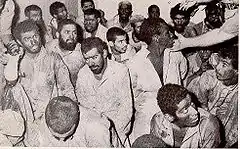
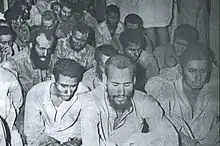
Shortly after news of the takeover was released, the new Islamic revolutionary leader of Iran, Ayatollah Khomeini, told radio listeners, "It is not beyond guessing that this is the work of criminal American imperialism and international Zionism."[45][46] Anger fuelled by these rumours spread anti-American demonstrations throughout the Muslim world—in the Philippines, Turkey, Bangladesh, eastern Saudi Arabia, the United Arab Emirates and Pakistan.[47] In Islamabad, Pakistan, on the day following the takeover, the U.S. embassy in that city was overrun by a mob, which burned the embassy to the ground. A week later, in Tripoli, Libya, another mob attacked and burned the U.S. embassy.[48][49]
Al-Qahtani was killed in the recapture of the mosque but Juhayman and 67 of his fellow rebels who survived the assault were captured and later beheaded.[11][12][13] The king secured a fatwa from the Council of Senior Scholars[11][12] which found the defendants guilty of seven crimes:
- violating the Grand Mosque's sanctity;
- violating the sanctity of the month of Muharram;
- killing fellow Muslims and others;
- disobeying legitimate authorities;
- suspending prayer at Masjid al-Haram;
- erring in identifying the Mahdi;
- exploiting the innocent for criminal acts.[50][51]
On 9 January 1980, 63 rebels were publicly beheaded in the squares of eight Saudi cities[12] (Buraidah, Dammam, Mecca, Medina, Riyadh, Abha, Ha'il and Tabuk). According to Sandra Mackey, the locations "were carefully chosen not only to give maximum exposure but, one suspects, to reach other potential nests of discontent."[13]
Policies
King Khalid, however, did not react to the upheaval by cracking down on religious puritans in general, but by giving the ulama and religious conservatives more power over the next decade. He is thought to have believed that "the solution to the religious upheaval was simple: more religion."[15] First, photographs of women in newspapers were banned, then women on television. Cinemas and music shops were shut down. School curriculum was changed to provide many more hours of religious studies, eliminating classes on subjects like non-Islamic history. Gender segregation was extended "to the humblest coffee shop," and religious police became more assertive.
Legacy
Mohammed bin Salman, the Crown Prince of Saudi Arabia, has pointed to the siege of the Grand Mosque and the Iranian Revolution of the same year as events that pushed Saudi Arabia in a more conservative direction for decades afterwards. In a 2018 interview with 60 Minutes he said that before 1979, "We were living a very normal life like the rest of the Gulf countries. Women were driving cars. There were movie theaters in Saudi Arabia. Women worked everywhere. We were just normal people developing like any other country in the world until the events of 1979."[52] While this image of pre-1979 Saudi Arabia is disputed,[53] the religious establishment did gain more power and money after 1979, leading to a stricter interpretation of Islam in society and the law, as well as increased international influence for Wahhabism.[54]
In popular culture
In 2018 the investigative documentary, The Siege of Mecca, directed by Dirk van den Berg and produced by Dirk van den Berg and Pascal Verroust, analysed the incident based on the reports of eye-witnesses and experts [55][56][57] and on previously unseen footage obtained during the research in Saudi Arabia.[58][59] In 2019, the NPR podcast Throughline released an episode on the "Siege of Mecca."[54]
See also
- Destruction of early Islamic heritage sites in Saudi Arabia
- Invasion of Mecca of 930
- Ikhwan revolt (1927–1930)
- List of Mahdi claimants
- Operation Blue Star (Golden Temple, Amritsar, June 1984)
- Siege of Lal Masjid (Islamabad, July 2007)
Notes
- Lacey 2009, p. 13.
- Da Lage, Olivier (2006). Géopolitique de l'Arabie Saoudite (in French). Complexe. p. 34. ISBN 2804801217.
- "THE SIEGE AT MECCA". 2006. Archived from the original on 6 July 2016. Retrieved 17 October 2018.
- Tristam, Pierre. "1979 Seizure of the Grand Mosque in Mecca". About.com. Archived from the original on 9 February 2017. Retrieved 1 November 2011.
- Riyadh (10 January 1980). "63 Zealots beheaded for seizing Mosque". Pittsburgh Post-Gazette. Archived from the original on 5 March 2016. Retrieved 12 November 2010.
- "1979: Remembering 'The Siege Of Mecca'". NPR.
- "How Did the Seizure of the Mosque and Mecca Influence al-Qaeda?". Archived from the original on 20 May 2019. Retrieved 14 November 2017.
- Mahboob Illahi (2 October 2018). Doctrine of Terror: Saudi Salafi Religion. FriesenPress. p. 139. ISBN 978-1-5255-2647-3.
- Miller, Flagg (2015). The Audacious Ascetic: What the Bin Laden Tapes Reveal About Al-Qa'ida. Oxford University Press. ISBN 9780190613396.
Not since the tenth century had such a maverick crew occupied Islam's holiest sanctuary, and for nearly two weeks Saudi Special Forces assisted by French commandos fought pitched battles to reclaim the compound.
- Benjamin, The Age of Sacred Terror (2002) p. 90
- 1979 Makkah – Grand Mosque aka Holy Mosque, Global Security
- "Saudis behead zealots". The Victoria Advocate. AP. 10 January 1980. Retrieved 7 August 2012.
- Mackey, Sandra. The Saudis: Inside the Desert Kingdom. Updated Edition. Norton Paperback. W.W. Norton and Company, New York. 2002 (first edition: 1987). ISBN 0-393-32417-6 pbk., p. 234.
- Wright, Robin (2001). Sacred Rage: The Wrath of Militant Islam. Simon and Schuster. p. 155. ISBN 978-0-7432-3342-2.
- Lacey, Robert (2009). Inside the Kingdom : Kings, Clerics, Modernists, Terrorists, and the Struggle for Saudi Arabia. Viking. p. 48.
'Those old men actually believed that the Mosque disaster was God's punishment to us because we were publishing women's photographs in the newspapers, says a princess, one of Khaled's nieces. The worrying thing is that the king [Khaled] probably believed that as well . . Khaled had come to agree with the sheikhs. Foreign influences and bida'a were the problem. The solution to the religious upheaval was simple—more religion.
- Benjamin, The Age of Sacred Terror, (2002) p. 90
- Wright, Sacred Rage, (2001), p. 152
- "Arabs in Paris Say 1,000 Joined Seizure of Mosque". The New York Times. 30 November 1979.
- Commins, David (2009). The Wahhabi Mission and Saudi Arabia. I. B. Tauris. p. 63.
It is important to emphasize, however, that the 1979 rebels were not literally a reincarnation of the Ikhwan and to underscore three distinct features of the former: They were millenarians, they rejected the monarchy and they condemned the wahhabi ulama.
- Lacey, Robert (15 October 2009). Inside the Kingdom: Kings, Clerics, Modernists, Terrorists, and the Struggle for Saudi Arabia. Penguin Group US. p. 9. ISBN 9781101140734.
- Wright, Looming Tower, (2006), p.88–9
- Lacey, Robert (2009). Inside the Kingdom: Kings, Clerics, Modernists, Terrorists, and the Struggle for Saudi Arabia. Viking. p. 31.
- Wright, Looming Tower (2006), p. 103 (softcover)
- Lacey, Robert (2009). Inside the Kingdom: Kings, Clerics, Modernists, Terrorists, and the Struggle for Saudi Arabia. Viking. p. 30.
Their language was curiously restrained. The sheikhs had a rich vocabulary of condemnation that they regularly deployed against those who incurred their wrath, from kuffar ... to al-faseqoon (those who are immoral and who do not follow God). But the worst they could conjure up for Juhaymand and his followers was al-jamaah al-musallahah (the armed group). They also insisted that the young men must be given another chance to repent. ... Before attacking them, said the ulema, the authorities must offer the option to surrender and lay down their arms.
- Wright, Looming Tower (2006), p. 102 (softcover)
- Benjamin, The Age of Sacred Terror, (2002), p. 90
- Wright, Looming Tower (2006), p. 104 (softcover)
- Wright, Looming Tower (2006), p. 101 (softcover)
- Pierre Tristam. "1979 Seizure of the Grand Mosque in Mecca: The Attack and the Siege That Inspired Osama bin Laden". About.com. Archived from the original on 30 May 2009. Retrieved 15 January 2014.
- Astal, Kamal M. (2002). "Three case studies: Egypt, Saudi Arabia and Iraq" (PDF). Pakistan Journal of Applied Sciences. 2 (3): 308–319. Retrieved 9 August 2012.
- Miller, Flagg (2015). The Audacious Ascetic: What the Bin Laden Tapes Reveal About Al-Qa'ida. Oxford University Press. ISBN 9780190613396.
- Irfan Husain (2012). Fatal Faultlines : Pakistan, Islam and the West. Rockville, Maryland: Arc Manor Publishers. p. 129. ISBN 978-1-60450-478-1.
- "Mecca 1979: The mosque siege that changed the course of Saudi history". BBC News. 27 December 2019. Retrieved 29 December 2019.
- Wright, Looming Tower (2006), pp. 103–104 (softcover)
- Wright, Looming Tower, (2006), p.92
- Saudi Opposition Group Lists Insurgents' Demands in MERIP Reports, No. 85. (February 1980), pp. 16–17.
- "US embassy cable of 22 November" (PDF). Retrieved 14 November 2017.
- Tristam, Pierre. "1979 Seizure of the Grand Mosque in Mecca The Attack and the Siege That Inspired Osama bin Laden". about.com. Archived from the original on 9 February 2017. Retrieved 17 March 2014.
- see also: Wright, Robin B., 1948| Sacred Rage: The Wrath of Militant Islam| Simon & Schuster| c 2001, p. 148
- see also Trofimov, Yaroslav (2007). The Siege of Mecca: The 1979 Uprising at Islam's Holiest Shrine. Random House.
- see also Prouteau, Christian (1998). Mémoires d'Etat. Michel Lafon. p. 265 through 277 and 280.
- " US embassy cable of 27 November" (PDF). Retrieved 14 November 2017.
- " US embassy cable of 1 December." (PDF). Retrieved 14 November 2017.
- Wright, Robin (2001). Sacred Rage: The Wrath of Militant Islam. Simon and Schuster. p. 148. ISBN 978-0-7432-3342-2.
- On This Day, 21 November, BBC
- "Khomeini Accuses U.S. and Israel of Attempt to Take Over Mosques", by John Kifner, New York Times, 25 November 1979
- Wright, Robin B., 1948. Sacred Rage: The Wrath of Militant Islam. Simon & Schuster, c 2001, p. 149
- [On 2 December 1979.] EMBASSY OF THE U.S. IN LIBYA IS STORMED BY A CROWD OF 2,000; Fires Damage the Building but All Americans Escape – Attack Draws a Strong Protest Relations Have Been Cool Escaped without Harm 2,000 Libyan Demonstrators Storm the U.S. Embassy Stringent Security Measures Official Involvement Uncertain, New York Times, 3 December 1979
- "'Active Measures': Forgery, Disinformation, Political Operations" (PDF). Inside the Cold War.org. United States Department of State Bureau of Public Affairs. October 1981. Archived from the original (PDF) on 1 June 2019. Retrieved 20 August 2016.
- Commins, David (2009). The Wahhabi Mission and Saudi Arabia. I.B.Tauris. p. 168.
- Salame, Ghassan (1987). "Islam and politics in Saudi Arabia". Arab Studies Quarterly. ix (3): 321.
- bin Salman, Mohammed (19 March 2018). "Saudi Arabia's heir to the throne talks to 60 Minutes". 60 Minutes (Interview). Interviewed by Norah O'Donnell. Riyadh: CBS News.
- Jamal Khashoggi (3 April 2018). "By blaming 1979 for Saudi Arabia's problems, the crown prince is peddling revisionist history". The Washington Post. Retrieved 25 August 2020.
- Ramtin Arablouei and Rund Abedelfatah (14 November 2019). "The Siege of Mecca". Throughline (Podcast). NPR. Retrieved 25 August 2020.
- Reem A. Meshal (November 2019). "The Siege of Mecca". Journal of Islamic and Muslim Studies. 4 (2).
- "the film's website THE SIEGE OF MECCA". Mecca 1979 - Investigative Documentary. OutreMer Film GmbH. Retrieved 14 November 2020.
- "THE SIEGE OF MECCA at the German documentaries film archive". The Siege of Mecca. German Documentary Association AG DOK. Retrieved 14 November 2020.
- "Interview Abdulaziz Al-Dhahri about archive footage (in German)" (Das Arabische Jahrzehnt). ZENITH - Candid Foundation gGmbH. Retrieved 14 November 2020.
- "The Siege of Mecca presented on DocumentaryTelevision". Documentary Television. Peter Hamilton Consultants, Inc. Retrieved 14 November 2020.
Further reading
- Aburish, Said K., The Rise, Corruption, and Coming Fall of the House of Saud, St. Martin's (1996)
- Benjamin, Daniel, The Age of Sacred Terror by Daniel Benjamin and Steven Simon, New York : Random House, (c2002)
- Fair, C. Christine and Sumit Ganguly, "Treading on Hallowed Ground: Counterinsurgency Operations in Sacred Spaces", Oxford University Press (2008)
- Hassner, Ron E., "War on Sacred Grounds", Cornell University Press (2009) ISBN 978-0-8014-4806-5
- Kechichian, Joseph A., "The Role of the Ulama in the Politics of an Islamic State: The Case of Saudi Arabia", International Journal of Middle East Studies, 18 (1986), 53–71.
- "Mecca Under Siege". NPR. 2020.
- Trofimov, Yaroslav, The Siege of Mecca: The Forgotten Uprising in Islam's Holiest Shrine and the Birth of Al Qaeda, Doubleday (2007) ISBN 0-385-51925-7 (Also softcover – Anchor, ISBN 0-307-27773-9)
- Wright, Robin B., Sacred Rage: The Wrath of Militant Islam, Simon & Schuster (2001)
- Wright, Lawrence, The Looming Tower: Al Qaeda and the Road to 9/11, New York: Knopf (2006) ISBN 978-0-375-41486-2 (Also softcover – New York : Vintage, ISBN 978-1-4000-3084-2)